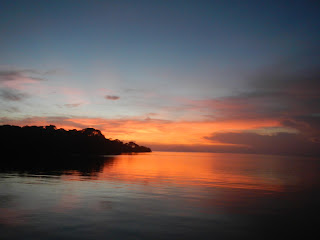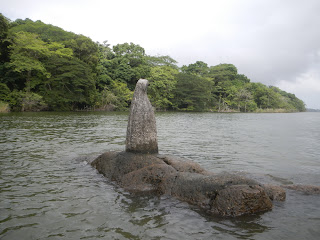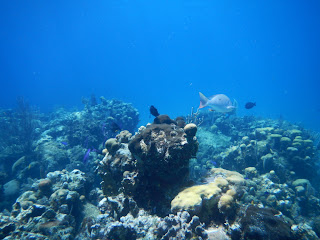So first up was Tela, a small town located between San Pedro Sula and La Ceiba. For anyone interested in seeing it, it's easily reachable, as any bus going between these two cities will pass Tela. Just tell your conductor and he'll inform you when to get off. I opted to take a chicken bus to try and save money, though I don't think it did. Unlike the other countries in Central America, using chicken buses in Honduras does not seem to be financially advantageous over using private lines when traveling within the country. When traveling across borders however, it may. While in Tela we explored the town a bit and visited the nearby village of El Triunfo de la Cruz. This place has a heavy Garifuna culture so we had hoped to find subjects for interview, but to no avail. We had however heard about a local radio station in town, and decided to go there for an interview with some of the hosts. Once there we were greeted warmly and quickly told that we'd be going into the broadcast room for a (what was intended to become) two-way on air interview. I should mention that whenever I tag along for these interviews it's assumed that I'm also a part of this project, thus my getting dragged into this scenario.
Anxiety immediately beset my friend, not because she isn't used to being on the air, but instead because neither of us have perfect spanish, and she was worried that her words may fail her (I having less refined spanish than hers would be of no help). Fortunately (or unfortunately, as I'm sure comedy would have ensued) a couple of the real guests who were scheduled to be interviewed on air showed up early, and we were exonerated of humiliation. The host offered to defer the appointment but our schedules did not align, and we were forced to return to Tela with nothing to add. The next day we moved on to La Ceiba.
While in La Ceiba we moved about both within the city as well as to the nearby villages of Corozal and Samba Creek. In Corozal we meant to witness an authentic candle-light vigil but the fun was rained out by the newly arrived rainy season. We waited for a couple hours in the wet darkness before calling it quits and returning to La Ceiba via taxi. For anyone interested in traveling to Corozal, a taxi costs 60 lempira to and from the town (about $3 US). Many taxi drivers will quote you much more and refuse to do it for less, but 60 lempira is the local rate, and I'd advice the thrifty traveler to hold out for an honest driver.
In Samba Creek we met with Omar "Babkle" Suazo, a relatively well known Garifuna artist who, after living in the U.S. for some number of years, has returned to his home to help run a living cooperative for his community. After my friends interview with the artist, we watched him conduct an outdoor meeting with his community, where they discussed land rights and plans for the construction of their new housing segment. It was interesting to see the way local business was conducted, and Omar's leadership with his people.
I can't say La Ceiba was my favorite city to be in, but while there we did get to witness much of the Honduran culture, including local Independence Day celebrations as well as a show put on by some local Garifuna performers. Plus the food was delicious as always...I've got nothing bad to say about the place. If you're looking to be amused by tourist attractions such as museums however, you ought to look elsewhere.
Our final destination on the Caribbean coast was Trujillo for some real relaxation. Trujillo is the furthest town east on the San Pedro Sula/La Ceiba highway. Best known for it's castle that (unsuccessfully) meant to defend from sea-borne threats, the town is also enjoyable simply in lieu of it's atmosphere. It's also quite well known for having good seafood, as these seaside villages generally are - but as budget travelers we were outpriced from trying it. The local hostel we stayed at, which had just been taken under new management, was an xtremely easy going way to spend a couple days. The (new) name of the place is "Tranquility Bay Beach Resort". It requires a bus (or cab) ride to get to, but was worth it. We mostly ate our own food or dined in town however, as the food is not cheap by local pricing standards.
Following Trujillo we boarded an overnight bus (approximately $18 US if I recall correctly) and headed on (or back I should say) to my next blog post, Tegucigalpa.
"The perfect place for imperfect people". This might be a show-stopper for those seeking perfection. (La Ceiba, Honduras)
Independence Day celebrations. (La Ceiba, Honduras)
Samba Creek isn't commonly sought by foreigners, but is packed with locals.
Samba Creek, Honduras
In case you were unaware, a public service announcement advising you not to feed alcohol to your baby. (Samba Creek, Honduras)
The Organization of Ethnic Community Development (ODECO) put on a show for us to demonstrate their local craft. (La Ceiba, Honduras)
La Ceiba, Honduras
Cemetary in Trujillo, Honduras
The view from atop the castle in Tujillo, Honduras
A model of the castle and it's pristine beachfront property (Trujillo, Honduras)
Within the castle, turned museum (Trujillo, Honduras)

















































































